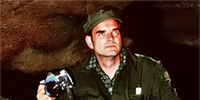Back to Don's Maps
 Back to Archaeological Sites
Back to Archaeological Sites
L'Abri du Cap Blanc - a frieze of prehistoric sculptures
L'Abri du Cap Blanc, which was discovered in 1909, is today the only frieze of prehistoric sculptures in the world to be shown to the public. All around this monumental frieze, a museographical area provides the visitor with an overview of Cap Blanc life and art. Objects, pictures, and a fresco tell the story of Prehistoric sculptors throughout Europe.

Panorama of a scene at L'Abri du Cap Blanc during the creation of the wonderful frieze there.
The artist who painted this Cap Blanc panorama is Gilles Tosello, a very well known illustrator of prehistoric times. My thanks to Bernard Nomblot for this information.
Artist: Gilles Tosello
Photo: Don Hitchcock 2008
Source: Display at Cap Blanc
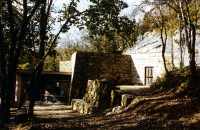 From the brochure for Cap Blanc, my thanks to Anya for this information:
From the brochure for Cap Blanc, my thanks to Anya for this information:
A few kilometres from Eyzies, the Cap Blanc Prehistoric Centre reveals another aspect of Prehistoric Art: Sculpture.
Over 15 000 years ago, Prehistoric hunters carved horses, bison and reindeer, some of which are over two metres long, straight into the Limestone cliffs.
Cap Blanc, which was discovered in 1909, is today the only frieze of prehistoric sculptures in the world to be shown to the public.
All around this monumental frieze, a museographical area provides the visitor with an overview of Cap Blanc life and art. Objects, pictures, and a fresco tell the story of Prehistoric sculptors throughout Europe.
Photo of the entrance to L'Abri du Cap Blanc, and text: Brochure for Cap Blanc, my thanks to Anya for this information.
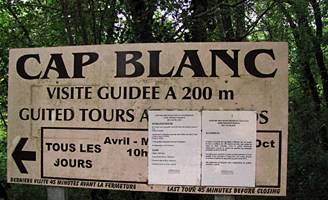
Sign leading to Cap Blanc.
Photo: Don Hitchcock 2008
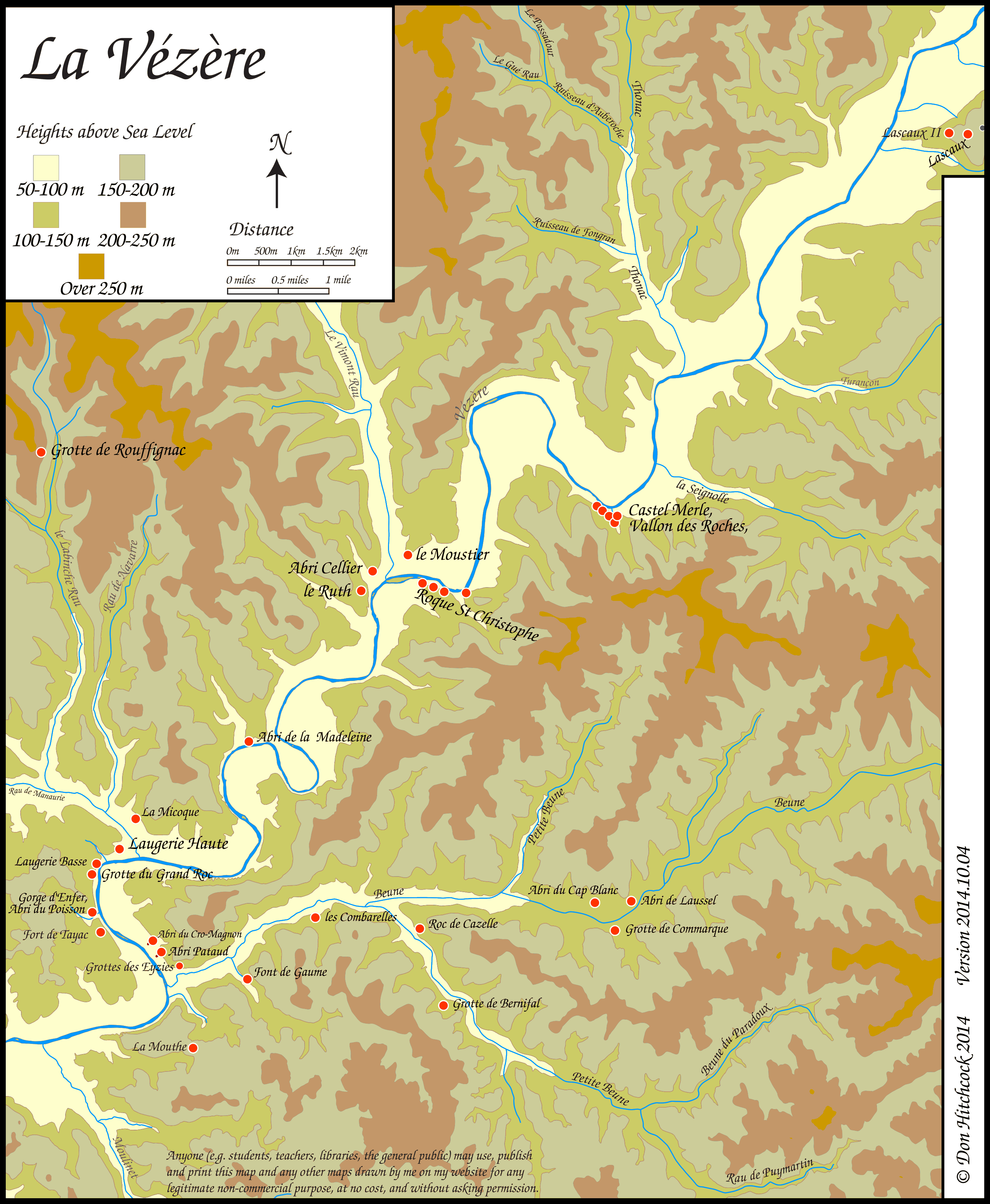
Map of sites in the Vézère Valley of France, including l'Abri du Cap Blanc.
If you click on the map you will see a larger map with the ability to click on the marked sites and get further information.
Photo: Don Hitchcock
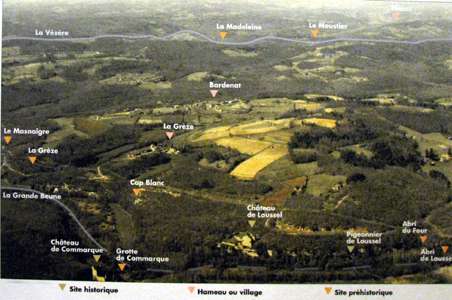
The area is rich in archeological treasures. Here is an aerial photograph of the area with the major sites.
Photo: Display at L'Abri du Cap Blanc.
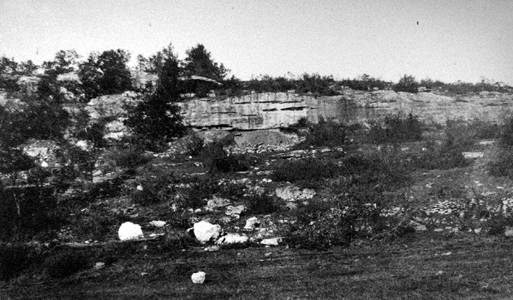
L'Abri du Cap Blanc seen from the bottom of the valley at the time when the excavations first began.
The Abri is hidden by the talus slope from the cliff above. The vegetation in this photo makes it difficult to gain an accurate picture of the site.
Photo: Display at Cap Blanc, originally from the Collection of the Musée d'Aquitane.
Text below translated by Don Hitchcock from: Castel et al (1992)
Abstract: Cap Blanc (Marquay, Dordogne, France) Results of the 1992 excavation regarding human activities and sculpture cultural attribution. In 1909, Bordeaux physician Gaston Lalanne hired local residents to excavate the Cap Blanc rock shelter, 6 km east of Les Eyzies. Lalanne's artefact collection and publication (1910) indicate a principal horizon relating to the Magdalenian. While a number of Solutrean-type artefacts were recognised in 1909, the Cap Blanc sculpted frieze has traditionally been assigned to the Magdalenian. In 1992, salvage excavation at Cap Blanc included the systematic screening of the 1909 backdirt. Many stone and bone artefacts were recovered, including seven fragments of Solutrean-type shouldered points.
There is now enough evidence to indicate a brief Solutrean occupation before the Magdalenian at Cap Blanc, and to reopen the question of the sculpted frieze age. In addition, the lithic and faunal remains recovered in 1992 are compared with those found in 1909. The combined evidence sheds light on the debitage economy and reindeer exploitation patterns of the alter Upper Paleolithic at Cap Blanc.
L'Abri de Cap Blanc is located 6 km east of Les Eyzies, in the valley of the Beune, a tributary of the Vézère. This paleolithic site is known primarily for its carved frieze attributed to the Magdalenian and the presence of a well-preserved human burial. It has been the object of excavations from the beginning of the 20th Century at which time very rudimentary methods were employed, with the exception of two more careful excavations by Denis Peyrony on the occasion of work to protect the site, and finally a more intense and careful trench by Alain Roussot and Jacques Tixier.
In 1992, the redevelopment of the protective structure of the site led to the organisation of a search of the original spoil of the early 20th Century excavations, firstly to identify possible fragments of sculptures which had been damaged during the first excavations, and secondly to recover archaeological material that had not been recognised in the early excavations.
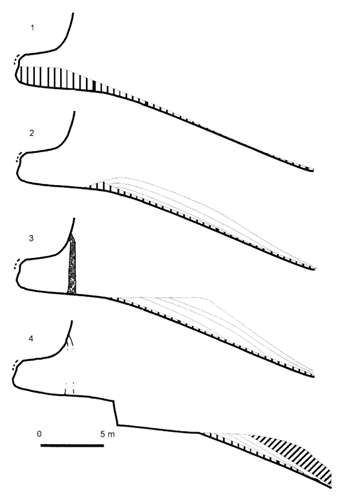
Figure 1 - Cap Blanc - Changing contours of the infill at the Abri (after Castel, 1992).
N-S schematic section with the sculpted wall on the left.
[1]: before 1909 (vertical hatching indicates the archaeological levels).
[2]: after the 1909 excavation.
[3]: after the construction of the original protective wall.
[4]: after the 1992 excavation and before the construction of the current protective wall (oblique hatching indicates the 1992 backdirt).
Photo: Castel et al (1992)
Much of the material collected in Cap Blanc (Collection Lalanne ) is housed at the Musée d'Aquitaine à Bordeaux, numerically smaller sets are kept in the National Musée National de Préhistoire aux Eyzies (collection Peyrony), Musée de l'Homme in Paris (collection Vésignié) and the Field Museum in Chicago. The site was discovered in 1908 by Raymond Peyrilles who worked on behalf of Gaston Lalanne Laussel. The excavation in 1909 was extremely fast (less than three months) and the sculptures were discovered at the end of the work. (Lalanne, 1910); (Lalanne et Breuil, 1911).
The almost complete human skeleton of an adult was discovered two years later, by D. Peyrony at the base levels of the excavation by Peyrille during the construction of the building to protect the carvings. The skeleton was sold in 1926 to the Field Museum in Chicago. In 1930, D. Peyrony carried out an excavation, of limited extent, in a zone less rich in relics, to the west of the excavation by R. Pyrille (Pyrony, 1950).
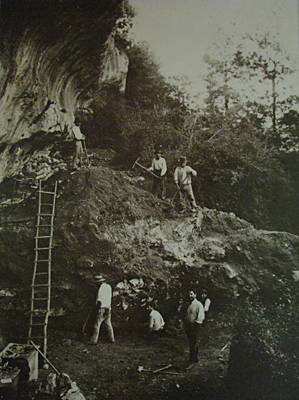
In 1909 and 1911, the same team of archaeological searchers, directed by Raymond Peyrille, was working on behalf of Dr G. Lalanne.
Note the handmade ladder, of available materials, and the pick and shovel techniques used to excavate the site, so different to the careful and painstaking methods used in modern archeological sites.
Photo: Display at Cap Blanc.
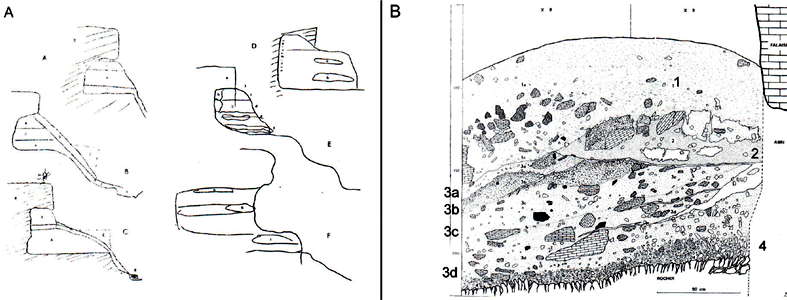
Cap-Blanc site stratigraphies :
a/stratigraphies from Lalanne excavations (Roussot 1972)
b/stratigraphy from Roussot excavations (Roussot 1972)
Photo: Bourdier et al. (2010)
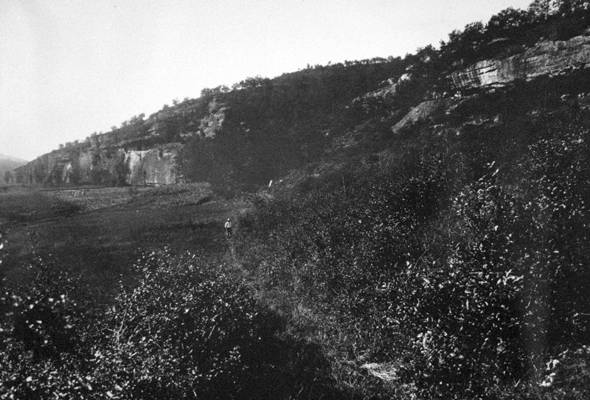
They were fortunate to discover two sites of the most remarkable prehistoric sculptures within a distance of just a few hundred metres, but separated in time by more than 10 000 years - the monumental frieze of Cap Blanc and the female bas-reliefs at Laussel.
Photo and text: Display at Cap Blanc.
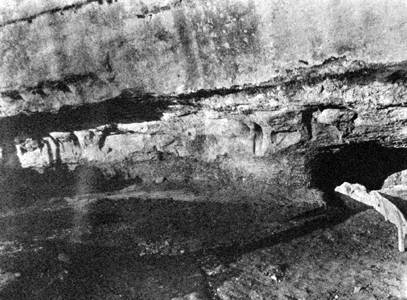
General view of the frieze at the time of its discovery in 1910.
In front of the wheelbarrow, to the right, one can see the block with a carved bison.
Photo: Display at Cap Blanc.
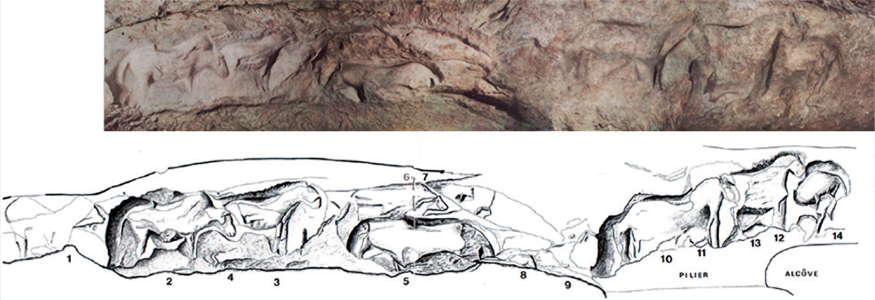
Cap-Blanc carved frieze.
Note the numbering system by Roussot (1994), which is used as a standard method to refer to individual elements of the frieze.
Photo J. Vertut Leroi-Gourhan (1965), tracing by Roussot (1994)

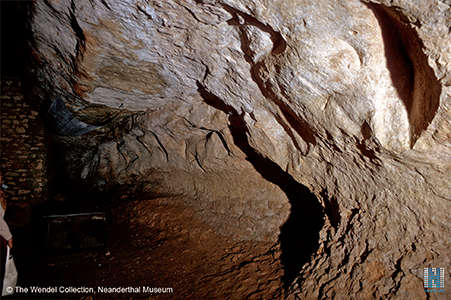
Cap Blanc frieze.
Photo: Heinrich Wendel (© The Wendel Collection, Neanderthal Museum)
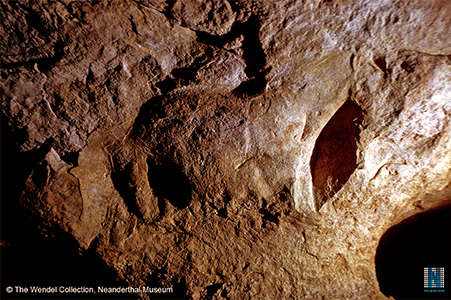

Cap Blanc frieze, horse 10
Photo: Heinrich Wendel (© The Wendel Collection, Neanderthal Museum)
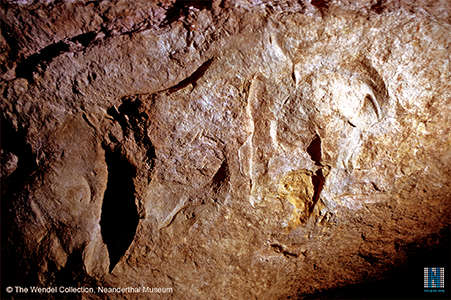
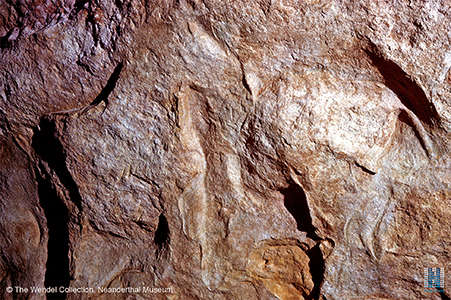
Cap Blanc frieze, horses 12 and 14
Photo: Heinrich Wendel (© The Wendel Collection, Neanderthal Museum)

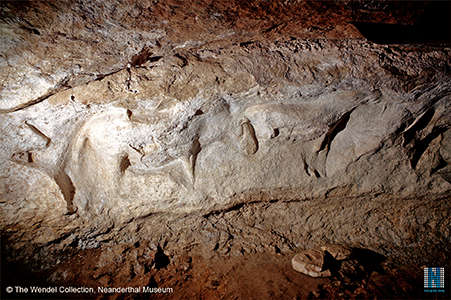
Cap Blanc frieze, horses 2 and 3.
Photo: Heinrich Wendel (© The Wendel Collection, Neanderthal Museum)
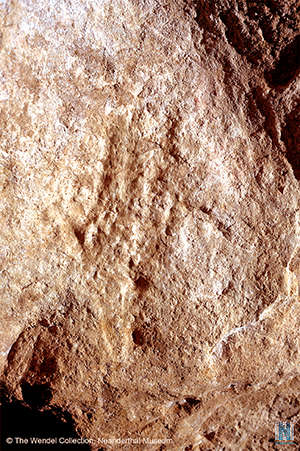
Cap Blanc engraved hand.
Photo: Heinrich Wendel (© The Wendel Collection, Neanderthal Museum)
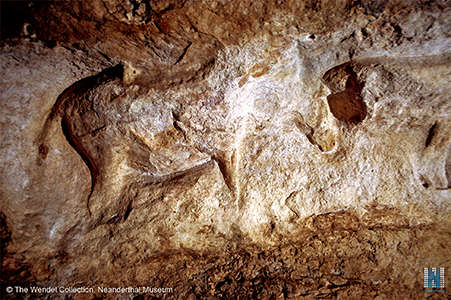
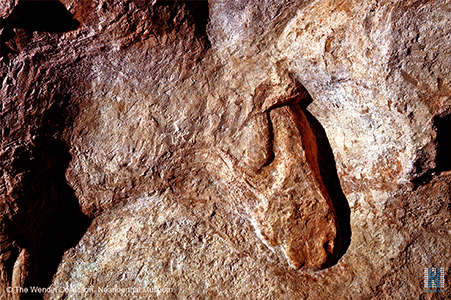
Cap Blanc frieze, horse 2.
Photo: Heinrich Wendel (© The Wendel Collection, Neanderthal Museum)
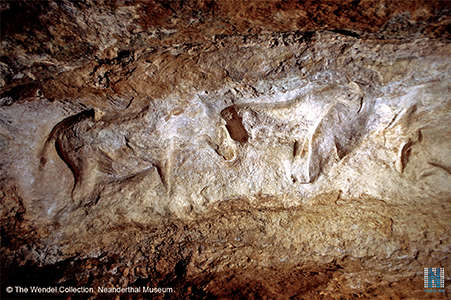
Cap Blanc frieze, left part of the frieze, horse 2 and 3.
Photo: Heinrich Wendel (© The Wendel Collection, Neanderthal Museum)
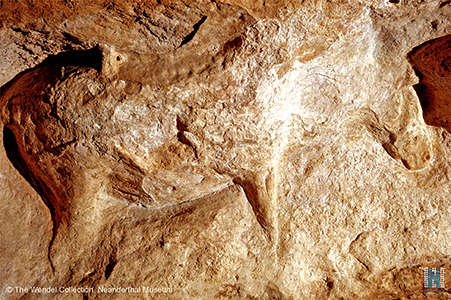
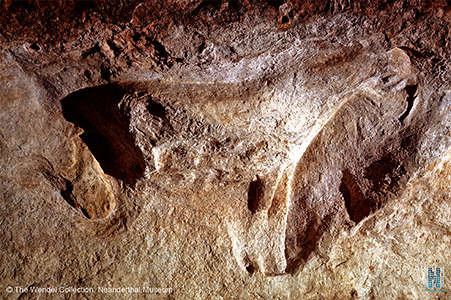
Cap Blanc frieze detail, left part of the frieze, horse 2 and 3.
Photo: Heinrich Wendel (© The Wendel Collection, Neanderthal Museum)
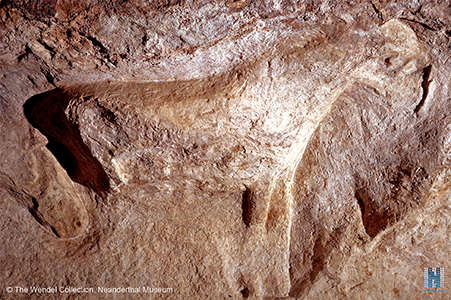
Cap Blanc frieze detail, left part of the frieze, horse 3.
Photo: Heinrich Wendel (© The Wendel Collection, Neanderthal Museum)
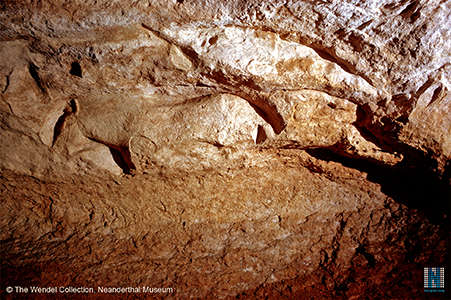
Cap Blanc frieze, middle part of the frieze, horse 5.
Photo: Heinrich Wendel (© The Wendel Collection, Neanderthal Museum)
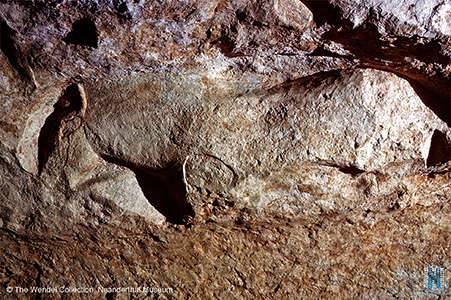
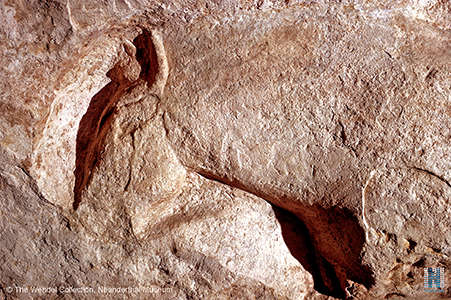
Cap Blanc frieze detail, middle part of the frieze, horse 5.
Photo: Heinrich Wendel (© The Wendel Collection, Neanderthal Museum)

Frieze of Cap Blanc
Photo: Brochure for Cap Blanc, my thanks to Anya for this information.
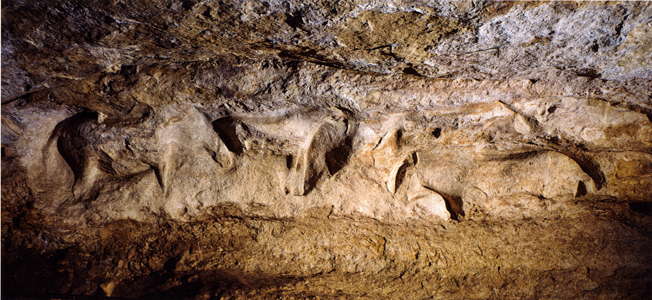
Frieze of Cap Blanc.
Photo: © N. Aujoulat-CNP-MCC. Desdemaines-Hugon (2010)
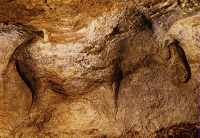
Horse from the Frieze of Cap Blanc
Photo: Brochure for Cap Blanc, my thanks to Anya for this information.

Deerheads
Photo: Brochure for Cap Blanc, my thanks to Anya for this information.
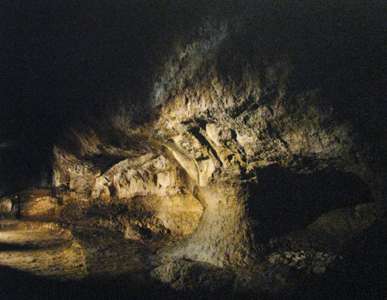
Cap Blanc as it appears today. The area is completely enclosed, and the visit includes a discussion by the guide about the history and significance of this site, which occupies a relatively small area. Photographs are not permitted.
There is a very good display outside the actual viewing area, which is well worth investigating in detail, and worth spending time in study of the objects presented there.
Photo: Display, Cap Blanc

Cap-Blanc plan with the indication of the alcove panel.
Photo Roussot (1984b)
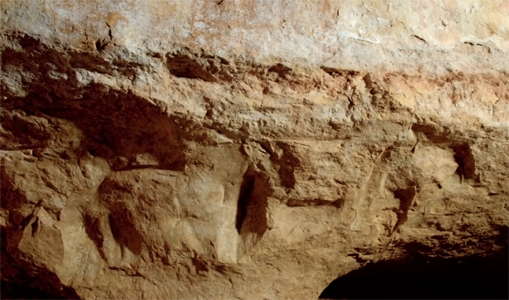
The alcove panel
Photo: C. Bourdier and O. Huard 2009, © CMN.
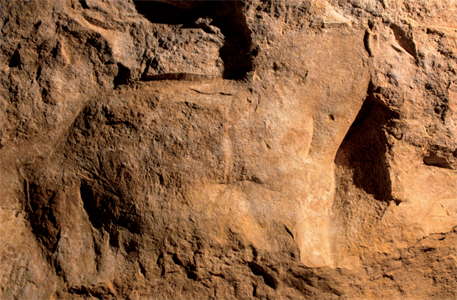
Cap Blanc horse number 10, shown above as part of the alcove panel.
The horse is shown in right profile, and is a huge bas-relief. It is 184 cm long, and 108 cm in height, and is in line with the other sculptures of horses in the panel.
The rump, the back, and the front of the horse are in good condition. The mane is shown in relief. The head has been damaged. Although the ears have delaminated somewhat, they are finely sculptured. The rest of the outline of the horse must be inferred more than followed exactly.
Photo: O. Huard 2008, © CMN.
Text: translated and adapted from Bourdier et al. (2010)
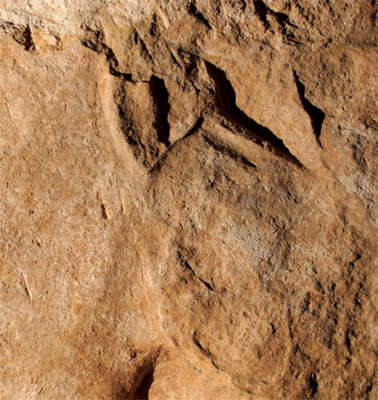
Horse ears detail, horse number 10, as above.
Note the subtly different lighting in the two shots, and the slight difference in the rotation of the photos.
Photo: O. Huard 2008, © CMN.
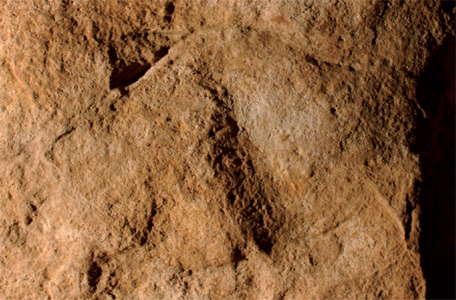
This small bison shown in left profile is located on the front part of the horse sculpture number 10, in the area one would expect to be below the belly of the horse, and behind the front legs. The shape of the bison can just be made out in the photo of the complete horse above.
The bison is only 34 cm long and 29 cm high, in marked contrast to the massive size of the horse of which it forms a part. The bison is easily recognised by the dorsal hump. The body is thick, the rear end has been pecked out, with one hind leg thin and short. There is no trace of a tail.
Photo: O. Huard 2008, © CMN.
Text: translated and adapted from Bourdier et al. (2010)
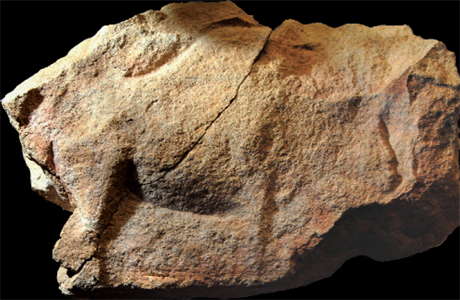
Bison carving found in 1909 in the alcove area panel.
There has been little obvious damage to this piece. The artist made full use of the existing relief of the wall, and appears to have been inspired by the natural contours available at the time the carving was completed.
Photo: Roussot (1994)
Source: Now in the Musée d'Aquitaine
Text: translated and adapted from Bourdier et al. (2010)
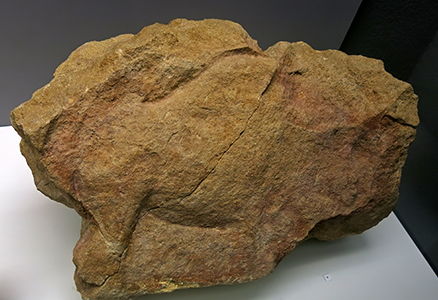
Representation of a bison, as above, Cap Blanc.
Material: Limestone
Age: Middle Magdalenian
Photo: Don Hitchcock 2015
Source: Original, Musée d'Aquitaine à Bordeaux
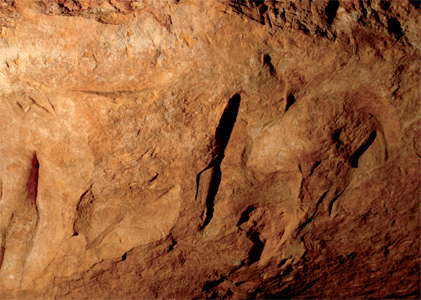
Horse number 12, bison number 13 and undetermined number 14, using the numbering system by Roussot shown above in a panorama and drawing.
This panel is on the far right of the frieze, to the right of horse number 10, shown above on this page.
The horse is in right profile, and is 128 cm long and 117 cm high. Some of it has been lost, but the outline is still clear. The line of the back includes a mane. The head has been almost completely erased. There is still an ear, forehead, and part of the muzzle. The lower contour of the head is reduced to the start of the jaw. The head has a unique teardrop shape, with an apparently pointed nose. The legs appear short, and the body thick. The horse has no thighs, buttocks or tail, and in their place is the head of the horse behind, number 10, as if it obscured the end of this one. It is not possible to determine the chronology of the two works.
Photo: C. Bourdier and O. Huard 2009, © CMN.
Text: translated and adapted from Bourdier et al. (2010)
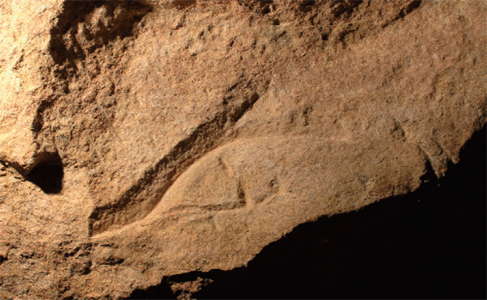
The small bison number 13, carved out beneath horse number 12, with dimensions of 35 cm width, 12 cm height.
The legs of horse 12 frame this small bison, shown in right profile, restricted in its entirety to a single cervico-dorsal line. It is impossible to know if the back of the bison is all there ever was, or if it is the sole remnant of a once more complete work.
Photo: C. Bourdier and O. Huard 2009, © CMN.
Text: translated and adapted from Bourdier et al. (2010)
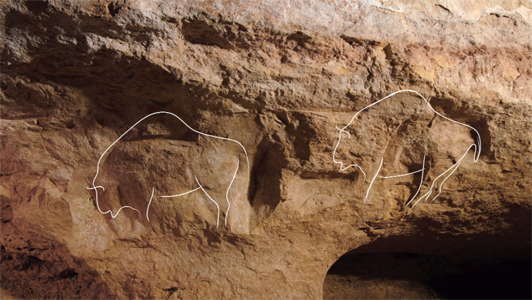
Residues of previous carvings lead to the hypothesis that there were two monumental sculptures of bison in left profile, as shown on this photo, which were trimmed and partially destroyed in order to make room for the two very large bas reliefs of horses in right profile discussed above. The two bison share a common technique of relief quite different from that used for the horses, highlighting their probable contemporaneity.
Photo: C. Bourdier 2009, © CMN.
Text: translated and adapted from Bourdier et al. (2010)
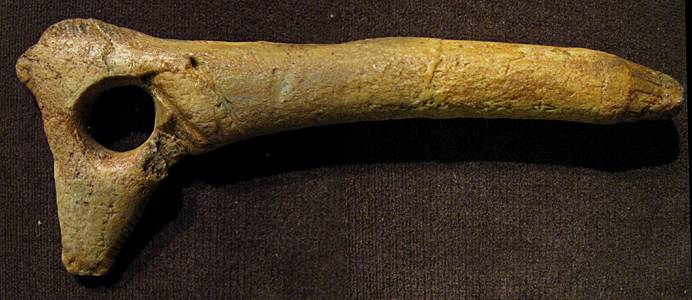
Bâton Percé.
Note that this bâton percé has not been significantly engraved with designs, testifying to its use as a simple tool, possibly for straightening spear shafts. At one time these objects were thought to perform some function as an indication of rank within the society, and were called Bâtons de Commandement by the first researchers.
Some are, indeed, elaborately decorated, which may be why they were thought to perform some ritual function.
They can also be used as a spear thrower, and have been demonstrated to perform this function with effectiveness.
Source: Facsimile, display at Cap Blanc
Photo: Don Hitchcock 2008
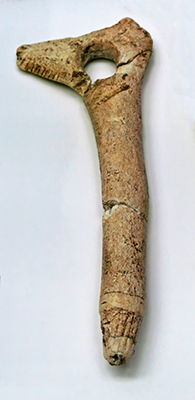
Pierced baton from Cap Blanc, as shown above.
Photo: Don Hitchcock 2015
Source: Original, Musée d'Aquitaine à Bordeaux
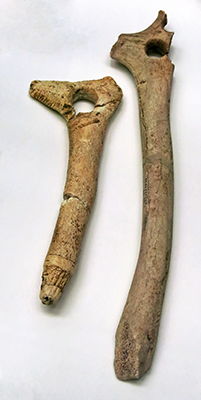
(right) Pierced baton from La Madeleine, Tursac, in reindeer antler.
(left) Pierced baton from Cap Blanc, as shown above.
Photo: Don Hitchcock 2015
Catalog: 60.524.1 (la Madeleine)
Source: Original, Musée d'Aquitaine à Bordeaux
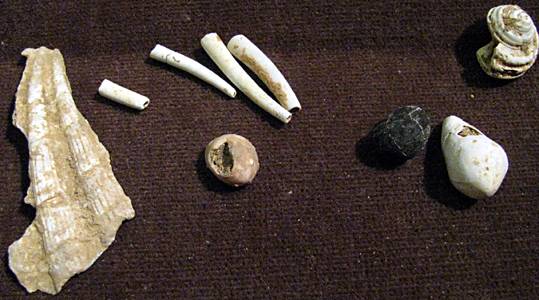
Jewellery found at Cap Blanc.
These appear to be from Jurassic Limestone deposits, not from contemporary shells on the Atlantic or Mediterranean coasts.
The long hollow shells are fossil Dentalium badense shells from Jurassic Limestone deposits, much prized by ancient peoples, with their modern analogues valued as ornaments, especially on the western coast of North America by the native peoples there.
Source: Apparently originals, display at Cap Blanc
Photo: Don Hitchock 2008
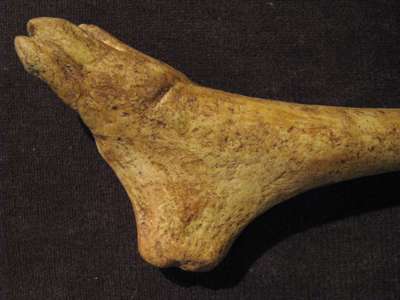
Bone object found at Cap Blanc.
Source: Facsimile, display at Cap Blanc
Photo: Don Hitchcock 2008
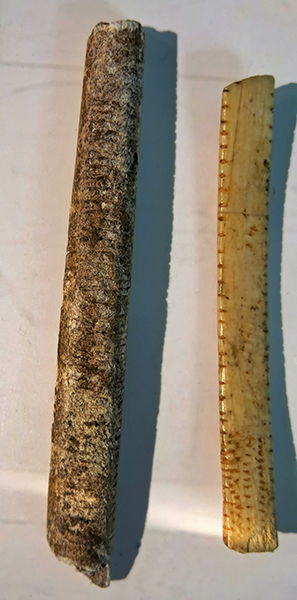
(left) Baguette demi-ronde, Cap Blanc.
Middle Magdalenian, made of reindeer antler.
Catalog: 61.3.315
(right) Engraved bone, Vieilmouly, Sireuil.
Recent Palaeolithic.
Catalog: 63.4.58
Photo: Don Hitchcock 2015
Source: Original, display at Musée d'Aquitaine à Bordeaux
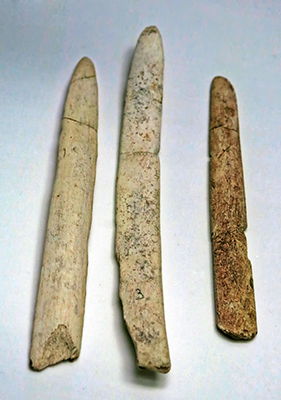
Lissoirs from Pair-non-Pair and Cap Blanc.
(left) Bone lissoir from Pair-non-Pair, 60.1060.4, Daleau collection.
(centre) Bone lissoir from Pair-non-Pair, 60.1060.5, Daleau collection.
(right) Reindeer antler lissoir from Cap Blanc, 61.3.306.
Photo: Don Hitchcock 2015
Catalog: 60.1060.4, 60.1060.5, 61.3.306
Source: Original, Musée d'Aquitaine à Bordeaux
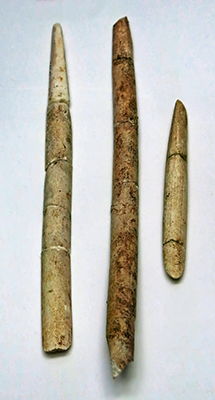
Baguettes demi-ronde from Cap Blanc.
Age: Middle Magdalenian
Small flints were sandwiched between two baguettes demi-ronde to make a harpoon or spear head.
Photo: Don Hitchcock 2015
Catalog: 61.3.308, 61.3.309
Source and text: Original, Musée d'Aquitaine à Bordeaux
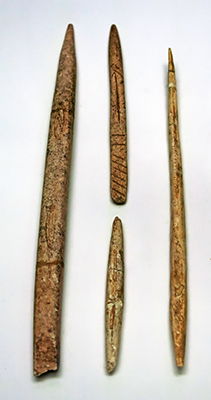
Sagaies or spear points from Cap Blanc, Marquay, and Reignac, Tursad.
Middle Magdalenian, in reindeer antler.
On the left in the photo above is the sagaie Catalog 64.4.4, from Reignac, length 220 mm, width 13 mm, thickness 10 mm. From the Hulin Collection.
At the centre top in the photo above is the sagaie Catalog 64.4.5, from Reignac, length 124 mm, width 9 mm, thickness 7 mm. From the Hulin Collection.
Presumably the others (catalog numbers were obtained from the display card) are two of 61.3.301, 302, and 304, from Cap Blanc, but they are not listed in the online catalog.
Photo: Don Hitchcock 2015
Catalog: 61.3.301, 61.3.302, 61.3.304, 67.4.4, 67.4.5
Source and text: Original, Musée d'Aquitaine à Bordeaux
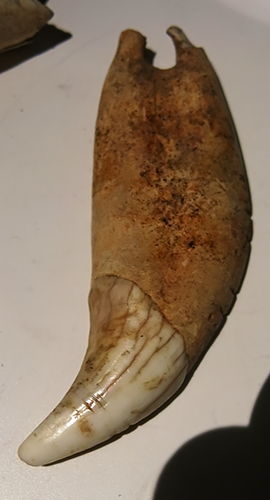
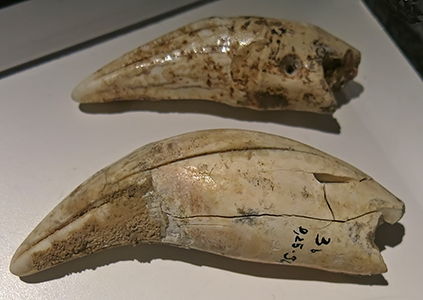
Pierced bear canines
Abri Lespaux, Saint-Quentin-de-Baron and Cap Blanc, Marquay.
Gravettian and Middle Magdalenian.
Catalog: 61.3.313
Photo: Don Hitchcock 2015
Source and text: Original, display at Musée d'Aquitaine à Bordeaux

Horse head in bas relief from Cap Blanc.
Material: Limestone
Age: Middle Magdalenian
Photo: Don Hitchcock 2015
Source and text: Original, Musée d'Aquitaine à Bordeaux
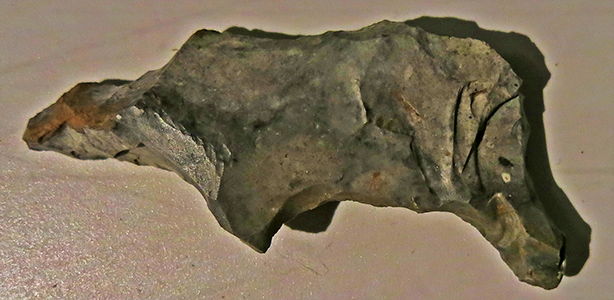
Animal representation from Cap Blanc, possibly of a bear.
Material: Flint
Age: Middle Magdalenian
Photo: Don Hitchcock 2015
Source and text: Original, Musée d'Aquitaine à Bordeaux

Animal figure in flint found at Cap Blanc.
Source: Facsimile, display at Cap Blanc
Photo: Don Hitchock 2008
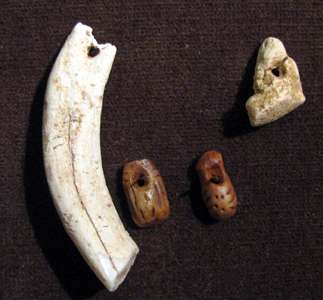
Jewellery objects found at Cap Blanc.
Source: White objects apparently original, darker carved beads (see below, from the 1909 backdirt) apparently facsimiles, display at Cap Blanc
Photo: Don Hitchock 2008

This is the original of one of the beads shown above, noted in the display as being in the form of a shell (?), from the Middle Magdalenian, made of bone.
Photo: Don Hitchcock 2015
Catalog: 61.3.314
Source: Original, Musée d'Aquitaine à Bordeaux
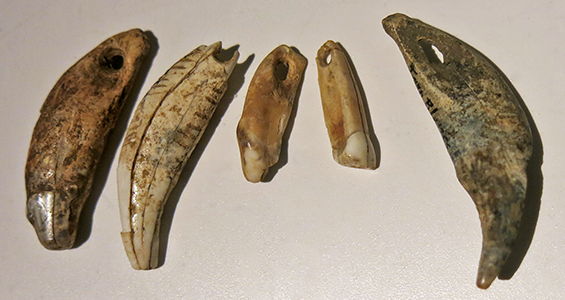
Pierced wolf canine and incisor teeth from Les Jean-Blancs, Bayac and Cap Blanc, Marquay
Age: Solutrian and Middle Magdalenian.
Photo: Don Hitchcock 2015
Catalog: 60.476.195, 60.476.195, and 61.3.312
Source and text: Original, display at Musée d'Aquitaine à Bordeaux

Flint points with curved backs, Cap Blanc.
Photo: Don Hitchcock 2015
Catalog: 61.3.281
Source and text: Original, display at Musée d'Aquitaine à Bordeaux
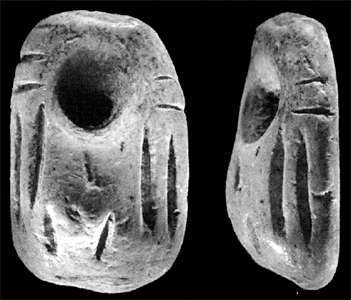
Cap Blanc - Ivory bead found in the 1909 backdirt (1992 excavation, Collection Archambeau)
Length: 16 mm. Photo by Ph. Jugie (Musée National de Préhistoire)
Photo: Castel et al (1992)
Table 1 - Faunal list from Cap Blanc
| Common Name | Number of remains identified | % Ungulates (hoofed animals) | Relative occurrence |
|---|---|---|---|
| Reindeer | 1558 | 92.6 | Very Abundant |
| Deer | 14 | 0.8 | Rare |
| Bovines | 15 | 0.9 | Rare |
| Ibex | 3 | 0.2 | Rare |
| Chamois | 3 | 0.2 | Rare |
| Saiga Antelope | 19 | 1.1 | Rare |
| Wild Boar | 1 | 0.1 | Rare |
| Horse | 70 | 4.2 | Fairly frequent |
| Wolf | 6 | Rare | |
| Fox | 3 | Rare | |
| Hare | 4 | Rare | |
| Large Vole | 2 | Rare | |
| Other Voles | 4 | Rare | |
| Total | 1702 |
Data obtained from Lalannes' 1909 excavations (after Delpech (1983)), Collection Musée d'Aquitane, Bordeaux, and proportional estimates for the 1909 backdirt (1992 excavation, Collection Archambeau).

Retouchers found at Cap Blanc in the 1909 backdirt during the 1992 excavation, Collection Archambeau. Two from reindeer and one from an unidentified large ungulate. Drawn by J.-G. Marcillaud.
Photo: Castel et al (1992)
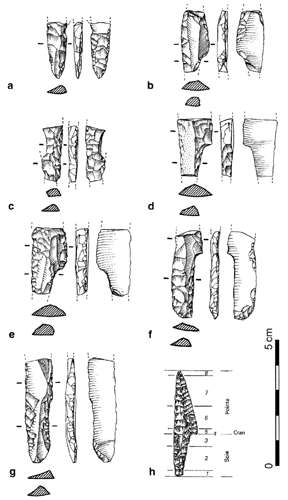
(a to g): Solutrean shouldered point fragments found in the 1909 backdirt, 1992 excavations, Collection Archambeau. Drawn by J.-G. Marcillaud.
(h) point fragment fracture locations.
Photo: Castel et al (1992)
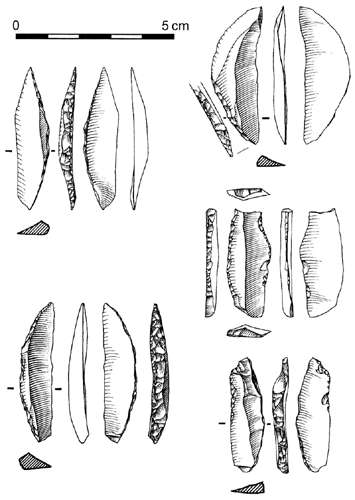
Azilian (following the Magdalenian, around 10 000 BP) points found in the 1909 backdirt from the 1992 excavation, Collection Archambeau. Drawn by J.-G. Marcillaud.
Photo: Castel et al (1992)

Grotte de Commarque is under the ruins of the Chateau de Commarque, not at the exact latitude and longitude shown on this photo, 44.941000N, 1.101000E which comes from http://www.megalithic.co.uk/
The ruins of the castle may be seen just above the marked latitude and longitude.
Photo: Google Earth

Engraving of a horse from the Grotte de Commarque.
Photo: Display, Cap Blanc

La Grotte de Commarque is located under the Chateau de Commarque, as seen here.
Photo: Jacques Wolkiewiez, http://www.archeociel.com/lascaux.htm
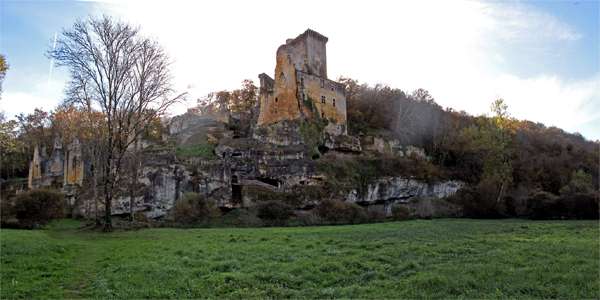
Chateau de Commarque. Various caves and shelters used by prehistoric people may be seen in the limestone under the Chateau in this photograph.
Photo: Happytrails, Panoramio
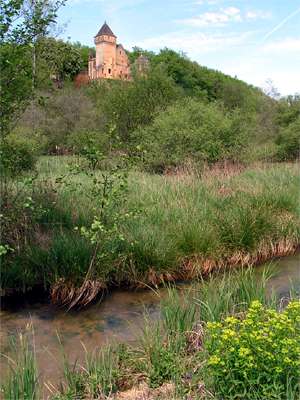
Rich meadow near Cap Blanc, between Chateau Laussel (pictured) and Chateau Commarque.
Photo: Hans Briaire, Panoramio

Laussel Grand Abri, upstream on the Beune from Cap Blanc.
Photo: © Yvan Lemeur, http://www.flickr.com/photos/lemeur/5719351234/
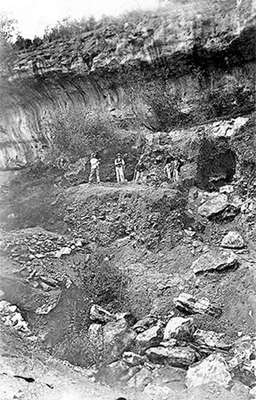
Laussel Grand Abri, view of the site at the moment of discovery of the Laussel Venus.
Photo de la collection Lalanne dans A. Roussot, 1990, p. 10, http://www.europreart.net/
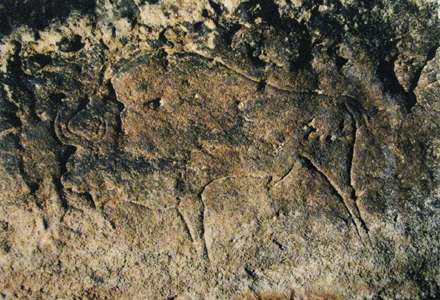
Engraving of a bison on the wall of the Grotte de la Grèze, not far from Cap Blanc.
Photo: N. Aujoulat, C.N.P.
Source: Display, Cap Blanc
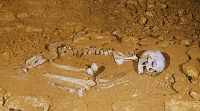
Skeleton in a grave. This is a cast of a skeleton found in the cave, rather than a real object. See the article below.
Photo: Brochure for Cap Blanc
The Cap Blanc Lady
The photos and text below are by Paul Bahn.
The complete article can be found at the website http://web.archive.org/web/20050204100005/http://jan.ucc.nau.edu/~evc/
From the text: Written in Bones: How Human Remains Unlock The Secrets of the Dead, edited by Paul Bahn (2003)
I have replaced many of the French accents and other things lost during the process of changing from the text into a pdf file.
Dr. Paul G. Bahn is a leading archaeological writer, translator, and broadcaster in the field of archaeology. He is a Contributing Editor of Archaeology magazine, a publication of the Archaeological Institute of America.
Dr. Bahn has written extensively on prehistoric art, including the books Journey Through the Ice Age, Rock Art and Prehistory, The Cambridge Illustrated History of Prehistoric Art, and sections on Paleolithic cave art in The Dictionary of Art. He has also authored and/or edited many books on more general archaeological subjects.
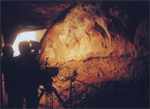 Television lighting helps to bring out the relief of the magnificent frieze at Cap Blanc, in particular the great central horse, 7 feet (2. 2 metres) in length. As with all Ice Age bas-reliefs known so far, it is thought that the frieze was originally painted too.
Television lighting helps to bring out the relief of the magnificent frieze at Cap Blanc, in particular the great central horse, 7 feet (2. 2 metres) in length. As with all Ice Age bas-reliefs known so far, it is thought that the frieze was originally painted too.
Photo: Cap Blanc Lady pdf file by Paul Bahn at http://jan.ucc.nau.edu/~evc/
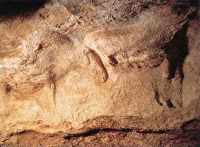
Two of the horses sculptured in haut-relief and bas-relief, facing right, on the back wall of the limestone rock-shelter of Cap Blanc. They are 1.9 metres (left) and 1.4 metres (right) in length.
Photo: Cap Blanc Lady pdf file by Paul Bahn at http://jan.ucc.nau.edu/~evc/
The limestone rock shelter of Cap Blanc, near Laussel, northeast of Les Eyzies in France's Dordogne region, is well known to the world of prehistory as the site of one of the finest sculptured friezes to survive the last Ice Age, the first to be unearthed, and currently the best to remain open to the public. Its figures of horses, bison and deer, albeit found in a much damaged condition at the time of their discovery by Dr. Gaston Lalanne of Bordeaux in 1909, remain a moving and powerful ensemble. Lalanne dug here and unearthed a fine collection of typical Magdalenian - about 15 000 years old - stone, bone and antler tools, including harpoons, and a number of large stone implements that had clearly been used to produce the parietal bas-relief and haut-relief sculptures that his crude excavations brought to light on the back wall. (Ed: Parietal - term used to describe artwork done on cave walls or large blocks of stone, as opposed to portable art, such as most of the venuses)
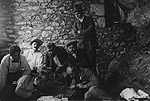
In 1911, further digging in front of the shelter for the purpose of erecting a small construction to enclose and protect the frieze and for lowering the floor level to make the art more visible to visitors led to the discovery of a human skull. Work was suspended and prehistorians Louis Capitan and Denis Peyrony were asked to extract the skeleton, a task that took them three days.
Above, the excavation of the Cap Blanc skeleton by Louis Capitan (left foreground) and Denis Peyrony (right foreground) in August 1911. The carved frieze is to the right.
Photo: Cap Blanc Lady pdf file by Paul Bahn at http://jan.ucc.nau.edu/~evc/
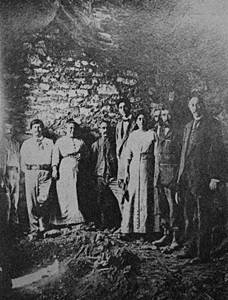
Photograph at the time of the discovery in 1911 of the Magdalenian burial. In the foreground the skeleton, exhumed by Denis Peyrony, who is in the centre of the group, accompanied by his wife.
Photo: Display at Cap Blanc.

Photograph at the time of the discovery in 1911 of the Magdalenian burial.
Photo: http://www.eurekalert.org/pub_releases/2006-03/fm-mgi030206.php
The Cap Blanc skeleton is of tremendous importance - not only a relatively intact inhumation from the late Ice Age but also one of the very few found in close proximity to parietal art of the period.
Indeed, the body's location directly in front of the central part of the shelter's sculptured frieze can really only be compared with that of the double paleolithic inhumation of an adult woman buried with her arm around a 17-year-old male dwarf in front of the engraved block at the Riparo di Romito, Italy. It was suggested by the excavators that the Cap Blanc burial may even be that of the original sculptor (or one of them), and this is unquestionably a possibility; certainly the location of the inhumation indicates a person with a strong link to the site.
Conflicting Reports
In France, the excavation of the skeleton in 1911 led to a brief publication that discussed primarily the two skeletons unearthed at La Ferrassie by the same excavators. They gave few details about the Cap Blanc find, stating only that the skeleton lay at the bottom of the archaeological deposit, 2. 3 meters from the frieze and 60 centimeters below the hooves of the central horse. It had been buried amid stones, with three fairly big stones placed above it, one of them on its head and others at its feet. It had been placed on its left side, arms and legs flexed, occupying a space of only 3 feet by 2 feet (1 meter by 60 centimeters), immediately below a Magdalenian hearth.It is curious that early reports of the Cap Blanc skeleton claimed that it was of a male aged about 25, whereas examination by physical anthropologists eventually established that it was of a young adult female.
A recent examination of the field Museum's archive on the case made it possible to reconstruct much of the story. The earliest document in the archive is a letter, dated January 24, 1911, to Monsieur J. Grimaud, the site's owner, from the president of the Société des Antiquaires de 1'Ouest in Poitiers, acknowledging receipt of a report on the rock shelters of Laussel (i.e. Cap Blanc) together with photos and five boxes, one containing reindeer teeth and bones and the other four containing flint tools. A letter, dated August 5, 1911, from Paul Leon, at the Ministère de l'Instruction Publique et des Beaux-Arts in Paris, thanks M. Grimaud for reporting the discovery of the skeleton and states that he will ask Peyrony to take appropriate measures to preserve it. Peyrony himself (the Membre Correspondant de la Commission des Monuments Historiques aux Eyzies) writes on August 8 that the Minister has asked him to verify the authenticity of the Laussel skeleton, make all necessary scientific observations, and supervise the excavation. He therefore went to the site that very morning and examined the find in the presence of Grimaud's guard, Veyret. The remains were indeed authentic.
Only two days later, Grimaud received a letter from Dr. Capitan, professor at the Collège de France, dated August 10, which is a key document for the site. The letter contains a sketch of the location of the bones and reports that they are 2. 3 metres from the big horse and around 70 centimetres below its muzzle. They occupy a kind of pit, 50 centimetres deep, and the skull was unfortunately broken by a blow from a workman's pickaxe.
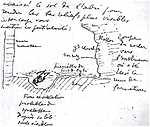 The sketch of the Cap Blanc lady's resting place, in a letter sent by Louis Capitan on August 10, 1911, to the site's owner, Monsieur Grimaud.
The sketch of the Cap Blanc lady's resting place, in a letter sent by Louis Capitan on August 10, 1911, to the site's owner, Monsieur Grimaud.
Capitan insists, rightly, that the excavation be carried out by experienced and qualified people and suggests himself and Peyrony for the task, as they have just unearthed the two older skeletons from La Ferrassie. To make matters clear, he proposes that the excavators produce the scientific report, while any finds would belong to Grimaud. In the meantime, the skeleton has been covered with stones and planks for its protection.
A new letter from Capitan, dated August 28, reports that the skeleton has been removed in its entirety in a number of blocks of earth, and it will now be possible to excavate the bones properly and carefully, once Peyrony has transported them to Paris by rail, probably in September or October. For the present, these blocks are in Peyrony's care, and he will dry them out slowly. Most important is a brief sentence, stating that "All we found with the skeleton was a shapeless fragment. probably of ivory." This is indeed a small ivory point measuring 0. 6 by 3 by 0. 4inches (16 by 74 by 10 millimetres), which is kept at the Field Museum, having been sold along with the skeleton.
It is described as "several thin laminae glued together along with bits of matrix and partially reconstructed or plastered over with some sort of filling material." According to its original display case label, this point was "found over the abdominal cavity of this individual" and "the weapon may have been the cause of death. "
This is certainly the theory that was promoted by Henry Field, the eventual acquirer of the skeleton for the museum. He claimed in a 1927 article that the skeleton died a natural death, yet also noted: A small ivory harpoon-point found lying just above the abdomen may give a possible clue to the cause of his death. This weapon may have caused blood poisoning which resulted in death. It has been suggested tentatively that the young man [sic] felt death approaching and returned to the rock-shelter, as he desired to die before the masterpiece he had helped to create. . . It is not plausible that some one who had nothing to do with the sculpture should have been allowed to desecrate the sanctuary unless he had assisted in the work or, at any rate, was directly connected with it.
In Field's memoirs, his speculations were even more romantic: "Why had she been buried beneath the frieze of horses? Was she killed by her lover's ivory lance point? Was it by another Cro-Magnon girl? Was her brother avenging the family's honor? Was she killed in battle? Why was she buried in the sanctuary? Was she the daughter of the sculptor-high priest? There was no real evidence, except that death probably resulted from blood poisoning."
No source is given for the theory that the ivory point was the cause of death or the claim that it was found above the abdomen - perhaps this was merely M. Grimaud's opinion - but nevertheless it is baffling that such a potentially important object was completely omitted from the published report by Capitan and Peyrony. Indeed, were it not for this casual mention in Capitan's letter, there would be absolutely no guarantee that the point had any connection with the Cap Blanc skeleton. Yet ivory is not common in Magdalenian contexts in southwest France, let alone ivory points that may be a cause of death. In this connection, it is worth noting that the only clear evidence we have of violence inflicted on humans during the last Ice Age consists of a probable flint arrowhead embedded in the pelvis of an adult woman from San Teodoro Cave, Sicily, and an arrowhead in the vertebra of a child from the Grotte des Enfants at Balzi Rossi, Italy.
A letter to Grimaud from Peyrony, dated August 31, 1911, notes that"we have been able to lift the whole thing in a pretty good state. The whole skeleton will be able to be reconstructed and will be a very good study piece. I have conserved it in Les Eyzies, as Mr Capitan was not able to take it. I will carry it to Paris next October. " However, it is clear that Capitan had major problems in getting the skeleton dealt with in Paris. Letters from him complain of the difficulty in finding someone qualified and with sufficient time available to prepare the bones for casting and display. It is also interesting to learn that there were plans afoot to have a cast made and placed in the shelter; in fact, for some reason this was never done, and instead a miscellaneous collection of casts of other bones was put together for this purpose. In a letter dated July 29, 1913, Capitan tells Grimaud that an artist will be sent to carry out this assignment. A letter from Grimaud in 1924 notes that "in accordance with the Ministere des Beaux Arts, I have had a modern skeleton set in place at the foot of the sculptures, in place of the real skeleton. "
Nevertheless, the original skeleton was eventually extracted from its sediments by J. Papoint of the Laboratoire de Paleontologie at the Musee National d'Histoire Naturelle under the direction of Marcellin Boule(director of the museum) and of Capitan. A letter from Papoint, dated February 27, 1915, records the state of the bones:
You will find the skull in the wooden box. It is in two pieces. It was impossible for me to reconstruct it because of the deformation caused by fossilisation. I left in the same block the upper and lower jaws as well as the seven cervical vertebrae which I extracted as well as I could. There are two upper incisors that I put to one side, since I could not fit them in their sockets. These two skull pieces are very fragile and need to be unpacked with care. The dorsal and lumbar vertebrae are all present. The ribs are incomplete. All the limb bones are in good condition. A few fragments of the shoulder-blades and pelvis bones are missing. This is due to the fragility of certain parts of these bones. A few phalanges are missing from the hands and feet.
The Sale of the Bones
By early 1915, the Cap Blanc skeleton had been restored to its owner. Monsieur Grimaud. It then disappeared from view until the start of his attempt to sell it to an American museum nine years later. According to Henry Field, "in 1916 M. Grimaud, having made no money out of the discoveries on his property, decided to reclaim his anticipated profit, and during the stress of war conditions was able to ship the skeleton to New York." In his later memoirs, he added that "the skeleton was said to have been smuggled out of France during World War I in a coffin as an American soldier with the necessary papers forged." Yet documentation available at the Field Museum provides no real clue as to why Grimaud decided to send it to America, or why he apparently waited a further eight years before trying to sell it. His initial choice was the American Museum of Natural History in New York, but, to cut a long story short, his protracted negotiations, via American lawyers in Paris, eventually came to nothing, in part because of his huge asking price ($12 000, equivalent to about $250 000 today).Finally, after steadily dropping his price, he sold it to Chicago's Field Museum for a much lower amount. According to Field's memoirs, a representative of the museum was sent to Monsieur Grimaud "with twenty-five thousand-franc bills (the equivalent of a thousand dollars) in one hand and a receipt ready for signature in the other. " He continues, "Some days later a cable came from Paris saying that the Cap-Blanc skeleton was ours. I hurried to New York and in the basement of the Museum of Natural History packed her very carefully in cotton wool and carried her in a suitcase to a compartment on the Twentieth Century [train]. We had a very uneventful night together. "
With the benefit of hindsight, Field's memoirs claim that, as he laid out the bones in Chicago, "the pelvic girdle was definitely feminine" - yet, as noted above, his article of 1927 still saw the skeleton as a young man! The skeleton in its new case was first displayed prominently just inside the museum's main entrance.
It was introduced to the media as "the only prehistoric skeleton in the United States" [sic], and so became front-page news. The first day, 22 000 visitors came to see for themselves. At noon, the crowd was so dense around her that the captain of the guard. . . notified the director that two guards must be placed there to keep the people moving and orderly. . . . [N]othing like this had happened before in the Field Museum. . . . This was the first exhibit in the new building to capture the public and press imagination. "
In 1932, the skeleton was withdrawn from exhibition so that the skull could be restored by T. Ito under the direction of Gerhardt von Bonin of the Department of Anatomy at the University of Illinois. According to von Bonin:
When the skeleton arrived at the Museum, it was in an almost perfectly clean condition, only a few bones being still embedded in a matrix of somewhat gritty, loam-like matter. The long bones were almost all perfectly preserved. The pelvic and the shoulder girdle were somewhat damaged, particularly in the pubic region and the scapula. The vertebral column appeared to be complete, the vertebrae were for the most part still held together by adhering soil. Twelve left and ten right ribs were found, and a rather decayed square piece of bone, apparently all that was left from the manubrium sterni. The cervical column was firmly attached to the lower jaw and a part of the upper jaw.
The skull was broken into a number of fragments. The bones are of a brownish colour, darker in some spots and lighter in others. They are firm enough to be handled conveniently, yet somewhat brittle. In some spots, dental cement had been put on the bones in order to prevent them from crumbling.
Von Bonin's conclusion, after a full anatomical study, was that these were the remains of a young woman, about 5 feet, 1 inch (156 centimeters) tall and about 20 years of age.
In an exhibition case next to the skeleton, the museum installed a life-size diorama of the Cap Blanc rock shelter, modeled by Frederick Blaschke. As the only complete European paleolithic skeleton on exhibition in an American museum, the Cap Blanc woman was seen by several million visitors in her first decade in Chicago alone. But the story does have a happy ending of sorts.
Thanks to the generosity of a private sponsor, a complete cast of the Cap Blanc lady - and of her ivory point - was recently made, and on July 14, 2001, the cast was installed in its rightful place beneath the central frieze in France.
 The cast of the Cap Blanc lady, restored to her original resting place in front of the center of the carved frieze on July 14, 2001.
The cast of the Cap Blanc lady, restored to her original resting place in front of the center of the carved frieze on July 14, 2001.
Magdalenian Girl Has Oldest Recorded Case Of Impacted Wisdom Teeth
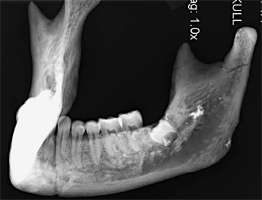
Earliest known impacted wisdom tooth. Digital radiograph (X-ray) of the mandible of Magdalenian Girl showing impaction of the right lower third molar (wisdom tooth). New high-quality radiographic imaging of the entire Magdalenian Girl skeleton, which is 13,000 to 15,000 years old, has made reanalysis of this skeleton possible. Photo courtesy of The Field Museum.
Photo: http://media.eurekalert.org/release_graphics/FM30206_3.jpg
Text: http://www.sciencebuzz.org/image/wisdom_teeth
by Staff Writers
Chicago IL (SPX) Mar 08, 2006
The earliest recorded case of impacted wisdom teeth belongs to the renowned "Magdalenian Girl," a nearly complete 13,000- to 15,000-year-old skeleton excavated in France in 1911 and acquired by The Field Museum in 1926.
For years this rare, early anatomically modern human skeleton was thought to be that of a girl because her wisdom teeth had not erupted, an event that typically occurs between 18 and 22 years of age. New analysis of Magdalenian Girl's bones, however, has lead Field Museum scientists to conclude that she was not a girl but actually a 25- to 35-year-old woman at the time of her death.
Examination of new high-quality digital X-rays revealed that the wisdom teeth were, in fact, impacted, and had thus failed to erupt at the normal time. This is significant because impacted wisdom teeth are thought to be the result of dietary changes associated with later developments in human cultures.
Impaction was unknown during the stone ages, scientists say, due to the coarse diet of the period. This coarse diet would have required more chewing and higher bite forces, which could have stimulated growth of the jawbone and thereby created more room for the wisdom teeth to erupt.
"Finding impacted wisdom teeth 15,000 years ago indicates that the human diet might have already changed, some would say 'deteriorated,' earlier than previously thought," said Robert D. Martin, Field Museum provost and primatologist.
Wisdom teeth are the common name for the third molars. There are usually four wisdom teeth (one in each row of teeth), and they grow in behind the second molars – provided they are properly aligned and there is enough room for them.
Martine, together with William Pestle, Field Museum Collection Manager and bone specialist, and Drs. Michael Colvard and Richard Jurevic of the College of Dentistry at the University of Illinois at Chicago, determined that Magdalenian Girl was a woman by employing new tools and technologies in an ongoing reanalysis of the specimen The determination that the wisdom teeth were, in fact, impacted allowed the researchers to make sense of a number of other indicators in the skeleton that suggested an age significantly older than 18-21.
"There had always been some tension between the young age suggested by the state of dental development and the much older age suggested by a number of developmental and degenerative changes in the rest of the skeleton," Pestle said.
Other tests currently underway include an analysis of tooth structures to confirm the age-at-death; computed tomography (CT) scans to study pathologies and the structure of the bones; stable isotope analysis to reconstruct the prehistoric diet; and DNA analysis.
The skeleton of the Magdalenian Girl, which is the most complete Upper Paleolithic skeleton available for study in North America, was discovered in 1911 near Laussel in southwestern France. The skeleton was found in the Cap Blanc rock shelter, famous for its magnificent decorative stone frieze of sculpted horses, bison and deer that is still visited by tourists today. Several years ago, The Field Museum created a cast of the skeleton for exhibition at Cap Blanc in France.
The original skeleton will be placed on permanent display as part of Evolving Planet, The Field Museum's stunning new permanent exhibit depicting the story of life on Earth. The exhibit opens to the public on March 10. For the first time, Magdalenian Girl's skeletal remains will be exhibit in the "fetal" position in which the specimen was discovered almost 100 years ago.
Martin, Pestle and other scientists will be on hand at the media preview of Evolving Planet on March 7 (see the information below for details) to discuss the new research findings relating to Magdalenian Girl, as well as other significant scientific news, such as the first exhibition of recently described dinosaur species.
When Henry Field, then curator of Physical Anthropology at The Field Museum, acquired Magdalenian Girl in 1926, it was hailed as one of the most significant acquisitions the museum ever made. On the first day the precious specimen was exhibited, tens of thousands of visitors flocked to the museum to see it.
Magdalenian Girl, also known as the Cap Blanc skeleton, continues to reveal significant information about our early human relatives – and she may not be done yet.
"Magdalenian Girl has once again proven the value of museum collections, which often contain unexpected secrets that are only revealed as new methods and techniques emerge," Pestle said.
References
- Bourdier C., Abgrall A., Huard O., Le Brun E., Peyroux M., Pinçon G. , 2010: Histoires de Bisons et de Chevaux: Regard sur l'évolution de la frise pariétale de Cap-Blanc (Marquay, Dordogne) à travers l’analyse du panneau de l’alcôve, Paleo No 21 2009 - 2010 pp. 17 - 38
- Castel, J., Chadelle J., 1992: Cap Blanc (Marquay, Dordogne), L'apport de la fouille de 1992 à la connaissance des activités humaines et à l'attribution culturelle des sculptures / Cap Blanc (Marquay, Dordogne), Paléo. N. 12, 2000. pp. 61-75.
- Delpech F., 1983: Les faunes du Paléolithique supérieur dans le Sud-Ouest de la France. Cahiers du Quaternaire, 6, Editions du CNRS.
- Desdemaines-Hugon C. , 2010: Stepping Stones, Yale
- Lalanne G., 1910: Un atelier de sculpture de l'Age du Renne. La Revue Préhistorique, 5, 33-44.
- Lalanne G. et Breuil H., 1911: L'abri sculpté de Cap-Blanc (Marquay, Dordogne) L'Anthropologie, 22, p. 385-402.
- Leroi-Gourhan A., 1965: Préhistoire de l’art occidental, Paris : Mazenod, 485 p. ill..
- Pyrony D. , 1950: Notes sur quelques petits gisements préhistoriques. Bulletin de la Société Historique et Archéologique du Périgord, 77, p.55-64.
- Roussot A., 1972: Contribution à l’étude de la frise sculptée du Cap Blanc. In : M. Almagro Basch, M. A. Garcia Guinea (Ed.), Santander Symposium, Symposium internacional de arte rupestre. Santander (14-20 septembre 1970). Madrid : Consejo superior de investigaciones, pp. 87-115, 5 fig.
- Roussot A., 1984a: Abri de Laussel, L’Art des Cavernes. Atlas des grottes ornées paléolithiques françaises, Paris : Ministère de la Culture, pp. 167-169.
- Roussot A., 1984b: Abri du Cap-Blanc, L’Art des Cavernes. Atlas des grottes ornées paléolithiques françaises, Paris : Ministère de la Culture, pp. 157-163.
- Roussot A., 1994: Visiter le Cap-Blanc, Bordeaux : Sud-Ouest, 32 p.
